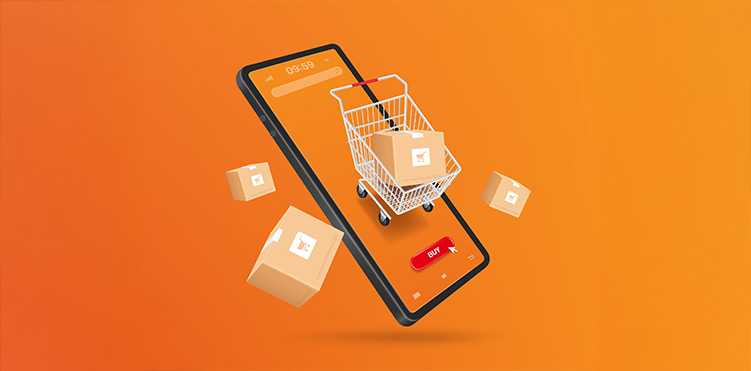Today, the surge of technology and connectivity has ushered in the era of online shopping. People appreciate the convenience and ease that comes with it, and about 61% of consumers globally say they prefer it over offline shopping. While businesses eagerly embrace this digital marketplace, many overlook a crucial component of success: e-commerce digital marketing. Your e-commerce marketing strategy influences your brand image and determines the public’s perception of you. It is directly linked to your profitability.
Let’s see exactly what e-commerce marketing is and some tips to help improve your online presence.
What is e-commerce marketing?
E-commerce marketing refers to strategies and techniques employed by online businesses to attract potential customers to their websites and mobile applications. The primary goal of e-commerce digital marketing is to drive traffic and convert visitors into loyal customers.
To achieve this, businesses implement various tactics tailored to specific target demographics. These may include search engine optimisation (SEO) to improve visibility in search results, pay-per-click (PPC) advertising to reach a broader audience, social media marketing to engage users, and email marketing to nurture relationships with existing customers.
Most e-commerce marketing strategies also use analytics tools to track user behaviour and measure the effectiveness of marketing campaigns. These tools can study which part of the website gets the most traction, what draws more attention and where users lose interest and drop off. This data can help businesses refine their strategies, ensuring they resonate with their intended audience.
The effectiveness of an e-commerce marketing strategy can directly impact a business’s growth and sales performance.
Tips and Tricks for E-commerce Marketing
While the e-commerce marketing strategy can vary from one organisation to another, certain steps can help your business grow exponentially.
Understand and Utilise SEO
Search engine optimisation (SEO) refers to identifying and using keywords in e-commerce digital marketing. With thousands of e-commerce websites, you need to make yours stand out. By incorporating SEO keywords into your product descriptions, URLs, and content, you can enhance your visibility and ensure your site appears in relevant searches. Without effective SEO, your content may get lost in the vast sea of online information.
Social Media Advertising
With the rise of doom-scrolling, social media has become integral in today’s e-commerce marketing strategy. Many people now make most of their purchases through applications like Instagram and Facebook. 72% of Indians report that they consult social media before buying anything.
Collaborations
Just having a social media account is not enough. You need to attract people to your page as well. Collaborating with influencers and social media personalities who share your brand’s interests can significantly enhance your e-commerce marketing strategy. These individuals have loyal followers who trust their opinions and recommendations.
By partnering with influencers who align with your values and target audience, you can authentically reach new customers. Their endorsements often feel more personal and relatable compared to traditional advertisements, which helps boost brand credibility and drive higher engagement.
Packaging
Many companies offer a bundling or hamper option on their digital platforms. Such options give customers the opportunity to buy their desired items at discounted rates. This attracts people to your site and pushes them to buy more products.
Moxie, a curly-hair company, also gives gifts like a makeup bag, scrunchies and laptop stickers with their bundles. Such offers make the customer feel like they are getting more value for their money.
Advent Calendars/Blind Boxes
Advent calendars or blind boxes are great examples of innovative packaging which also offer great opportunites for collaborations. Traditionally, an Advent calendar is a special calendar used to count down the days to Christmas. Typically, starting on December 1st, it has 24 numbered doors that open to reveal a chocolate or a bible proverb. Soon, companies started making their advent calendars with their products, hidden behind these doors.
With the rise of social media, advent calendars have stopped being a solely Christmas tradition and have taken over all the seasons. Companies like Sephora, Cadbury, Disney and even Netflix have their own calendars. Usually, they send these boxes to Instagram and YouTube artists who make unboxing videos and show the products to the world.
The excitement of not knowing what you have and the anticipation of finding out make these boxes fun for all. This is why companies have also started giving such items on a smaller scale in the form of blind boxes. These boxes usually contain only one or two products and allow people to experience this rush of emotions while spending less.
Girl Math
“Girl math” was a popular trend on Instagram some time ago, highlighting how women often calculate whether they should invest in a product. For example, if a t-shirt costs Rs 800 and they expect to wear it 20 times, the cost per wear would be Rs 40. This “girl math” approach suggests the product is worth the expense.
What began as a joke offers valuable insights into consumer behaviour. Some websites have now incorporated this concept, displaying the cost per wear alongside the total price of an item. This is a great example of how social media can be useful not only to put out content, but also to learn about the market.
Quizzes and trivia
Incorporate online quizzes and trivia questions wherever feasible. For example, a company selling skin care products can offer customers a quiz to understand their skin type and needs before directing them to suitable products. This establishes a quick rapport with the consumer and shows them you care. It will also set you apart and help get repeat customers.
Target audience
It is no secret that Gen Zs and Gen Alphas are drastically different from older generations. The e-commerce marketing strategy will vary based on the generation you want to cater to. You need to identify your audience and identify things that will appeal to them.
For example, Myntra has a whole section dedicated only to Gen Z. This section contains clothing, footwear, accessories and beauty products curated specifically for the taste of the younger generation. This gets them more traction and helps them better understand their clientele.
Agencies like ODigma can help with the process of creating SEO driven content across platforms. As experts in the e-commerce digital marketing space, they can also help you come up with more modern, innovative and captivating marketing strategies to boost your business to the next level.
Final Thoughts: Secure Your Place in the E-Commerce Spotlight
In the “chronically online” era, your online presence determines how your business is received by the masses. Your e-commerce digital marketing must be just as robust and creative as the product or service you provide. Make regular, SEO-driven content curated and made specifically for your audience. Experiment with styles and look at different platforms for inspiration. Jump onto the social media bandwagon and collaborate with people to increase your reach. Interact with your audience; no post or story is small. Use these tools to study these interactions and understand what works and what doesn’t. Packaging matters as well, so along with offers and bundles, experiment with how to package the item.
The world is at the tip of your finger; all you have to do is reach out and grab it!
Frequently Asked Questions
1. What is e-commerce marketing
It is the process of using online techniques to improve your online presence and draw people to your product.
2. Why is digital marketing important for e-commerce businesses?
It helps attract new customers, boost online visibility, increase sales, build brand awareness, and improve customer loyalty—all cost-effectively.
3. What is SEO?
SEO or search engine optimisation is the process of taking certain steps, like using keywords, to make your content stand out in search results.
4. How does social media presence affect sales?
Most people today buy items from or after consulting social media. The social media presence of an e-commerce company can directly affect their sales.


 Digital Marketing For Doctors In India
Digital Marketing For Doctors In India A Comprehensive Guide to Programmatic Advertising (2025)
A Comprehensive Guide to Programmatic Advertising (2025) How to choose the Best Search Engine Marketing (SEM) agency in Bangalore
How to choose the Best Search Engine Marketing (SEM) agency in Bangalore Social Media Marketing for Healthcare: The 5 Step Plan
Social Media Marketing for Healthcare: The 5 Step Plan Content Marketing for Startups: Building Brand & Driving Growth on a Budget
Content Marketing for Startups: Building Brand & Driving Growth on a Budget